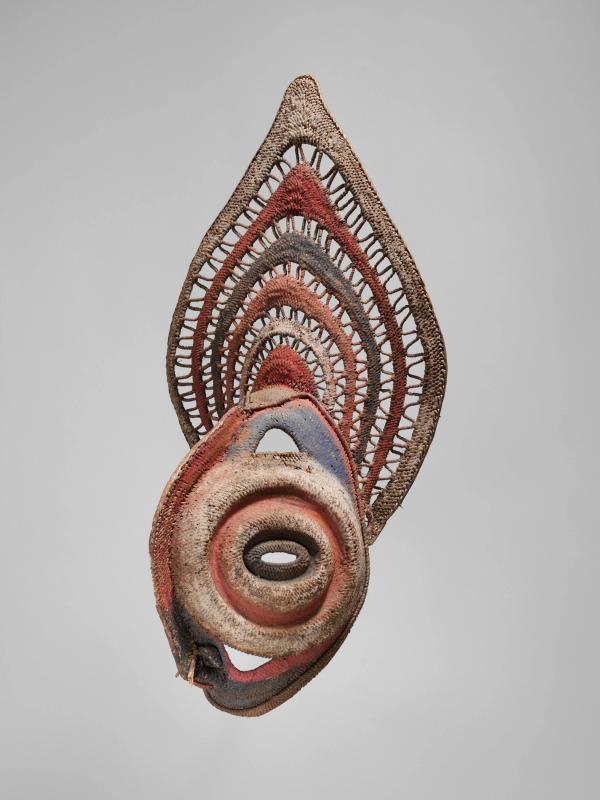Yam Mask
following the annual harvest, later receiving those of his rival in return. Men who are consistently able to give their partners longer yams than they receive gain great prestige. Lavishly adorned for the presentation ceremony, the finest long yams are essentially transformed into human images, decorated in the manner of men in full ceremonial regalia. The “heads” of the enormous tubers are adorned with specially made yam masks such as this one, which are made exclusively for yams and are never worn by humans.
Artwork Details
- Title: Yam Mask
- Date: early to mid-20th century
- Geography: Papua New Guinea, Prince Alexander Mountains, Middle Sepik River region
- Culture: Abelam people
- Medium: Fiber, paint
- Dimensions: H. 28 in. × W. 12 1/2 in. × D. 10 1/4 in. (71.1 × 31.8 × 26 cm)
- Classification: Basketry-Sculpture
- Credit Line: The Michael C. Rockefeller Memorial Collection, Purchase, Nelson A. Rockefeller Gift, 1965
- Object Number: 1978.412.858
- Curatorial Department: The Michael C. Rockefeller Wing
Audio

1783. Yam mask, Abelam artists
Ludovic Coupaye
KATERINA TEAIWA (NARRATOR): This mask wasn’t made for a person. Instead, it was meant to adorn a large yam.
DR. LUDOVIC COUPAYE: Many parts of the world, but I would say particularly in the Pacific, plants have a very central role. And the question that we might ask ourself is, “Why?”
My name is Ludovic Coupaye. I am currently an associate professor at the Anthropology Department of University College, London.
KATERINA TEAIWA: In the region of Papua New Guinea where this mask was made, yams are part of a complex cycle.
DR. LUDOVIC COUPAYE: Their practice of planting, cultivating, harvesting, decorating, and displaying those massive tubers.
KATERINA TEAIWA: On ceremonial occasions, gardeners decorate and display their yams with masks like these. Some yams reach up to 9 feet in length.
DR. LUDOVIC COUPAYE: They check the length, the smoothness of the skin of the yam, the shape, which is quite important. But they ask about the history of that particular tuber. Where did the original seed came from? So, who is the cultivator, who is the gardener? What is his association, what are his network of relation?
KATERINA TEAIWA: Yams themselves are likened to individual people. When yam plants grow, their roots and vines form branches—a bit like family trees. While yams do produce seeds, this isn't how they reproduce. If you take a small piece of yam and plant it elsewhere, new yams will grow from that original tuber.
DR. LUDOVIC COUPAYE: That means that when we look at a yam today, we look at a very old individual that has been reproduced over and over a generation.
KATERINA TEAIWA: And when young men are initiated into adulthood, they crawl into the ceremonial house as if they are going underground.
DR. LUDOVIC COUPAYE: They become themself a yam, going underneath and emerging decorated with exactly the same type of ornaments that you put on yams. Or reversely, the yams are decorated exactly as the initiate.
More Artwork
Research Resources
The Met provides unparalleled resources for research and welcomes an international community of students and scholars. The Met's Open Access API is where creators and researchers can connect to the The Met collection. Open Access data and public domain images are available for unrestricted commercial and noncommercial use without permission or fee.
To request images under copyright and other restrictions, please use this Image Request form.
Feedback
We continue to research and examine historical and cultural context for objects in The Met collection. If you have comments or questions about this object record, please contact us using the form below. The Museum looks forward to receiving your comments.
